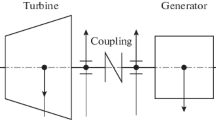Abstract
The article presents the results of studying the effect of forces associated with secondary damping coefficients (gyroscopic forces) on the development of asynchronous rolling of the rotor over a water-lubricated bearing. The damping forces act against the background of other exciting forces in the rotor–supports system, in particular, the exciting forces of contact interaction between the rotor and bearing. The article considers a rotor resting on supports rubbing against the bearing and the occurrence of self-excited vibration in the form of asynchronous roll-over. The rotor supports are made in the form of plain-type water-lubricated bearings. The plain-type bearing’s lubrication stiffness and damping forces are determined using the wellknown algorithms taking into account the physical properties of water serving as lubrication of the bearing. The bearing sliding pair is composed of refractory materials. The lubrication layer in such bearings is thinner than that used in oil-lubricated bearings with white metal lining, and there is no white metal layer in waterlubricated bearings. In case of possible deviations from normal operation of the installation, the rotating rotor comes into direct contact with the liner’s rigid body. Unsteady vibrations are modeled using a specially developed software package for calculating the vibration of rotors that rub against the turbine (pump) stator elements. The stiffness of the bearing liner with the stator support structure is specified by a dependence in the force–deformation coordinate axes. In modeling the effect of damping forces, the time moment corresponding to the onset of asynchronous rolling-over with growing vibration amplitudes is used as the assessment criterion. With a longer period of time taken for the rolling-over to develop, it becomes possible to take the necessary measures in response to actuation of the equipment set safety system, which require certain time for implementing them. It is shown that the gyroscopic damping components facilitate the developing rolling of the rotor over the bearing. If measures taken to decrease these components in the damping devices and bearings are met with success, the onset of asynchronous rolling-over with the growing amplitudes occurs after a longer period of time.
Similar content being viewed by others
References
R. Gasch, “Vibration of large turbo-rotors in fluid-film bearings on an elastic foundation,” J. Sound Vib. 47, 53–73 (1976).
R. J. Williams, “Parametric study of reverse whirl instability using an analytikal equilibrium model,” BRITE_EURAM Project ROSTADYN Technical Report No. 4.17 (1996).
E. L. Poznyak, “Torsional impact in the shaft line at sudden and strong imbalance,” Mashinovedenie, No. 5, 66–74 (1987).
L. Ya. Banakh, “Contact problems in rotor systems,” in Proc. 22nd Int. Conf. on Vibroengineering, Moscow, Oct. 4–7, 2016; Vibroeng. Proc. 8, 90–96 (2016).
V. F. Shatokhin, Doctoral Dissertation in Engineering (All-Russia Thermal Engineering Inst., Moscow, 2014).
V. F. Shatokhin, Oscillations of Turbounit Rotors with Generation Roll of the Rotor over the Stator (Methods of Modeling and Software Tools) (Lambert Acad., Dusseldorf, 2016).
V. F. Shatokhin, “Influence of the damping components in supports on the shape of the manifestation of the generation roll of the rotor over the stator,” in Proc. 9th Int. Sci.-Tech. Conf. on Problems of Vibrations, Vibration Adjustment, Vibration Monitoring and Diagnostics of the Equipment of Power Stations, Moscow, Nov. 21–24, 2017 (Vseross. Teplotekh. Inst., Moscow, 2017).
V. F. Shatokhin, “Forces exciting generation roll at rotor vibrations when rotor-to-stator rubbing,” Therm. Eng. 64, 480–489 (2017). doi 10.1134/S0040601517070072
O. G. Zav’yalov, Doctoral Dissertation in Engineering (St. Petersburg State Univ., St. Petersburg, 2009).
A. G. Kostyuk, V. F. Shatokhin, and O. A. Volokhovskaya, “Motion of an imbalanced rotor when it rubs against the stator,” Therm. Eng. 59, 87–95 (2012).
V. F. Shatokhin, “Development of the generation roll of the imbalanced rotor over the stator,” Elektr. Stn., No. 11, 17–28 (2013).
P. I. Orlov, Fundamentals of Machine Design: Handbook, 3rd ed. (Mashinostroenie, Moscow, 1988; Mir, Moscow, 1976).
Author information
Authors and Affiliations
Corresponding author
Additional information
Original Russian Text © V.F. Shatokhin, 2018, published in Teploenergetika.
Rights and permissions
About this article
Cite this article
Shatokhin, V.F. Rotor Rolling over a Water-Lubricated Bearing. Therm. Eng. 65, 93–97 (2018). https://doi.org/10.1134/S0040601518020052
Received:
Accepted:
Published:
Issue Date:
DOI: https://doi.org/10.1134/S0040601518020052



